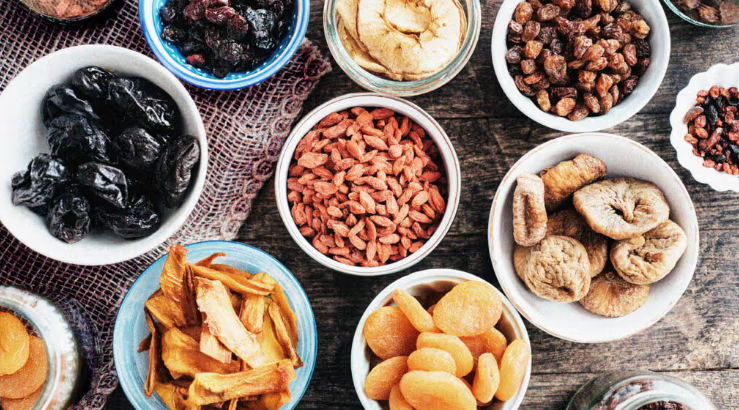- Contrary to existing concerns, consuming dried fruit appears to reduces the risk of type 2 diabetes, according to a new study.
- While dried fruits are convenient, tasty, and full of nutrients, they are also high in natural sugars, a concern for people hoping to avoid type 2 diabetes.
- Experts recommend eating dried fruits in portion-controlled amounts, and as one component of a well-balanced diet.
Consuming more dried fruits is associated with a lower risk of type 2 diabetes in a newly published study. The study hopes to resolve conflicting evidence regarding their value for people hoping to keep their blood sugar levels under control, due to the fruits’ concentrated amounts of sugar.
The study — which appeared in BMC Nutrition & MetabolismTrusted Source — found that increasing dried fruit intake by about 1.3 pieces daily may lower the risk of type 2 diabetes by up to 60.8%.
Dried fruits are flavorful, convenient and healthful, and are less perishable, making them attractive snacks. The study looked at consumption of dried prunes, dried apricots, and raisins.
In addition to being rich in macro and micronutrients, dried fruits include plenty of fiber that may help control blood sugar levels and improve digestive health.
They also contain flavonoids that have been linked to improved insulin sensitivity and they have anti-inflammatory properties.
The concern is that they contain concentrated amounts of natural sugar that may result in rapid spikes in glycemia (blood sugar) shortly after eating.
This can undermine an individual’s attempts to maintain stable glucose levels. Until recently, their consumption was largely discouraged for people at risk of type 2 diabetes, although the authors of the study describe a recent shift in this view.
The study analyzed Genome-Wide Association Study (GWAS) data based on UK Biobank data for approximately 500,000 people.
These data included 421,764 participants’ responses to questionnaires regarding the number of dried fruits they habitually consumed daily. One prune, a single apricot, and 10 raisins were all considered one portion for the purposes of the questionnaire.
Additional response options included “less than one,” “do not know,” and “prefer not to answer.”
The GWAS study also included genotypic and various phenotypic data for participants. Their questionnaire answers were compared to type 2 diabetes statistics derived from the IEU OpenGWAS database, including 61,714 people with type 2 diabetes and 593,952 controls.
An analysis of, or comparison with, the health benefits of fresh fruits was beyond the scope of this study. Thus, the study does not suggest dried fruits are superior to fresh fruits for blood sugar control.

Thank you for the auspicious writeup It in fact was a amusement account it Look advanced to more added agreeable from you By the way how could we communicate
Magnificent beat I would like to apprentice while you amend your site how can i subscribe for a blog web site The account helped me a acceptable deal I had been a little bit acquainted of this your broadcast offered bright clear idea
What i dont understood is in reality how youre now not really a lot more smartlyfavored than you might be now Youre very intelligent You understand therefore significantly in terms of this topic produced me personally believe it from a lot of numerous angles Its like women and men are not interested except it is one thing to accomplish with Woman gaga Your own stuffs outstanding Always care for it up
Usually I do not read article on blogs however I would like to say that this writeup very compelled me to take a look at and do it Your writing style has been amazed me Thank you very nice article
obviously like your website but you need to test the spelling on quite a few of your posts Several of them are rife with spelling problems and I to find it very troublesome to inform the reality on the other hand Ill certainly come back again
you are in reality a just right webmaster The site loading velocity is incredible It seems that you are doing any unique trick In addition The contents are masterwork you have performed a wonderful task on this topic
I do not even know how I ended up here but I thought this post was great I dont know who you are but definitely youre going to a famous blogger if you arent already Cheers
Hi Neat post Theres an issue together with your web site in internet explorer may test this IE still is the marketplace chief and a good component of people will pass over your fantastic writing due to this problem